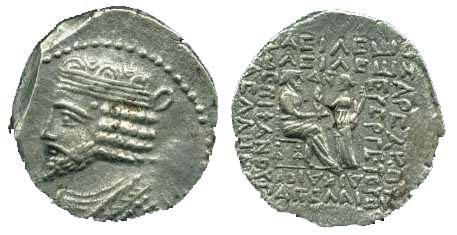| 40 AD - 45 AD |
Βαρδάνης Α'
| Teradrachm / Τετράδραχμον AR |
SHH 1883 |
 |
| Parameter Obverse Reverse Notes Reference Acquired Composition |
13.52 g 25.1-26.8 mm 12:00
o'clock VF σmax(SigmaTest, 240 Hz) = obv. 12.2 rev 16.0 MS/m μ-XRF Cu-Core ground edge 62 % Cu Diademed and cuirassed bust left with short beard; wart on forehead; within circular border of dots. King enthroned right, receiving palm-branch from tyche standing left, holding cornucopiae; ΔΝΤ between their heads (year 354 SE = 42/43 AD); above ΒΑCΙΛΕΩC / ΒΑCΙΛΕΩΝ, on right ΑΡCΑΚΟΥ / ΕΥΕΡΓΕΤΟΥ, beneath inverted ΔΙΚΑΙΟΥ, on left ΕΠΙΦΑΝΟΥC / [ΦΙ]ΛΕΛΛΗΝ[ΟC], in exergue month (off flan). Silver with copper alloy core. Copenhagen 154/155; Sear Greek Imperial 5787v 4.11.2002 XRF-Analysis, surface patina Rathgen OXFORD-Analyser
|
|
Vardanes
I (40 - 45 AD)
http://57.1911encyclopedia.org/V/VA/VARDANES.htm
VARDANES I., succeeded
Artabanus II., probably his father, in AD. 40
(Joseph. Ant. xx. 3, 4), but had continually to fight against his rival
Gotarzes (q.v.). The coins show that he was in full possession of the
throne from 42 to 45. In 43 he forced Seleucia on the Tigris to submit
to the Parthians again after a rebellion of seven years (Tac. Ann. xi.
9). Ctesiphon, the residence of the kings on the left bank of the
Tigris, opposite to Seleucia, naturally profited by this war; and
Vardanes is therefore called founder of Ctesiphon by Ammianus Marc.
xxiii. 6. 23. He also prepared for a war against Rome, with the aim of
reconquering Armenia (cf. Joseph, Ant. xx. 3, 4), but did not dare to
face the Roman legions (Tac. Ann. xi. 10). In a new war with Gotarzcs
he gained a great success against the eastern nomads. He is praised by
Tacitus as a young and highly gifted ruler of great energy (cf.
Philostratus, Vita Apollon. Tyan. ~. 21. 28), hut lacking in humanity.
In the summer of 45 he was assassinated while hunting, and Gotarzes
became king again.
|